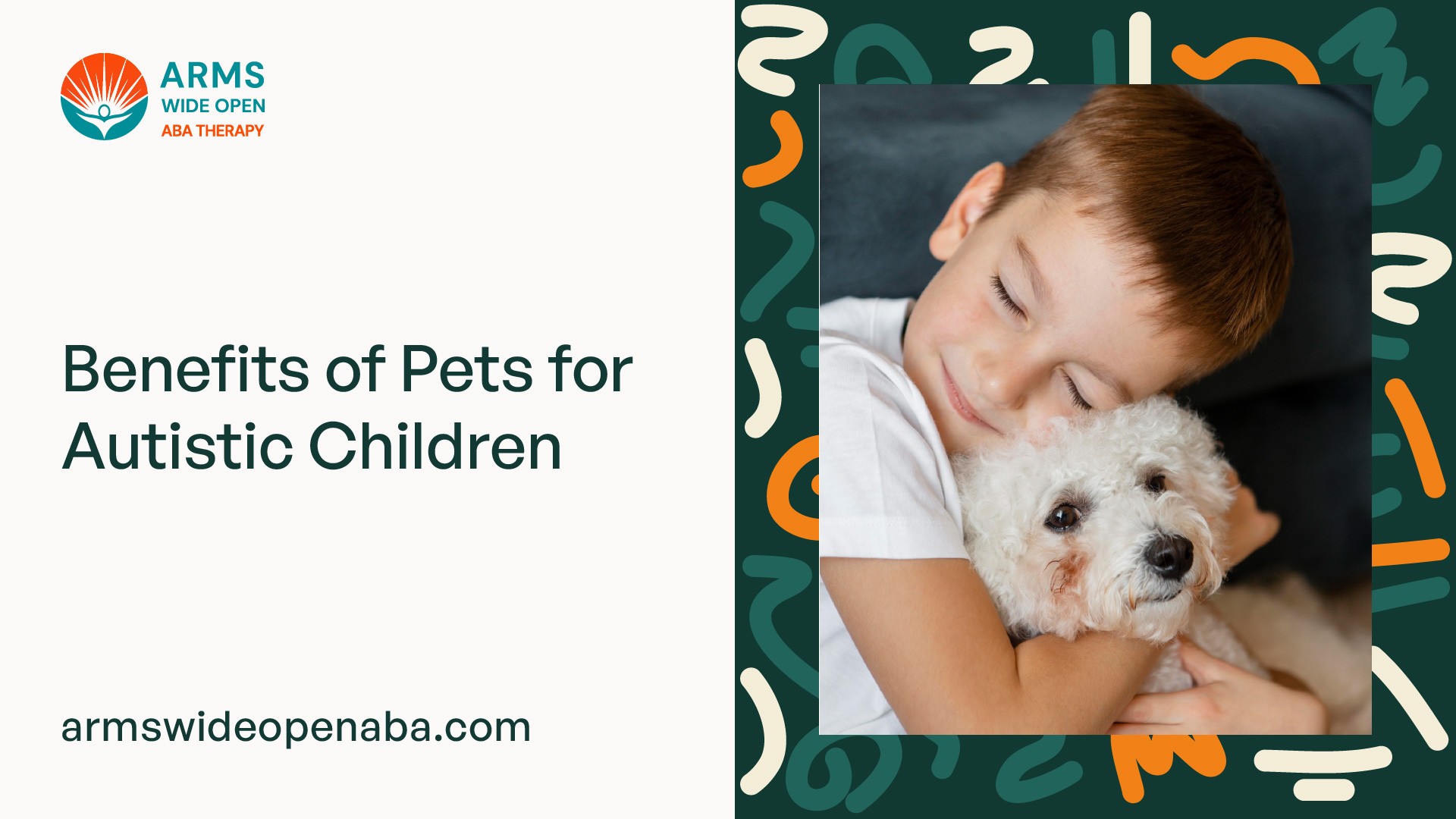Benefits of Pets for Autistic Children
Discover the paws-itive benefits of pets for autistic children. From companionship to improved social skills, find out how furry friends make a difference!

Understanding Autism and Pets
For autistic children, the presence of pets can have a profound and positive impact on their well-being. Understanding the benefits of pets in supporting autistic children begins with gaining an overview of Autism Spectrum Disorder (ASD) and recognizing the role that pets play in their lives.

Overview of Autism Spectrum Disorder
Autism Spectrum Disorder is a neurodevelopmental disorder that affects communication, social interaction, and behavior. It is characterized by a wide range of symptoms and challenges that vary from person to person. Some common characteristics of ASD include difficulties in social communication, repetitive behaviors, sensory sensitivities, and challenges in adapting to changes in routine.
Role of Pets in Supporting Autistic Children
Pets play a significant role in supporting autistic children by providing various benefits that can positively impact their overall well-being. The presence of pets can help improve emotional well-being, enhance social and communication skills, and provide sensory stimulation. Additionally, pets can teach responsibility and help establish routine and structure in the lives of autistic children.
By understanding the unique needs of autistic children and recognizing the positive impact that pets can have, families and caregivers can make informed decisions about introducing pets into the lives of these children. It is essential to consider the specific benefits that pets can bring to autistic children and the considerations that need to be taken into account when welcoming a pet into the family.
Continuing to explore the emotional, social, and sensory benefits that pets provide for autistic children will shed light on the remarkable support and companionship they can offer.
Emotional Benefits
Pets can have a profound impact on the emotional well-being of autistic children. The presence of a furry friend can provide companionship, comfort, and a sense of security.
Companionship and Comfort
Having a pet can be a source of constant companionship for autistic children. Pets offer unconditional love and acceptance, creating a strong bond that can be especially beneficial for individuals who struggle with social interactions. The presence of a pet can help reduce feelings of loneliness and provide a sense of emotional support.
Furthermore, autistic children often find solace in the non-judgmental nature of animals. Pets offer a safe space where children can be themselves without fear of criticism or rejection. The simple act of petting or cuddling with a furry friend can bring comfort, soothing anxiety and promoting relaxation.
Reduction of Stress and Anxiety
Pets have a remarkable ability to reduce stress and anxiety levels in autistic children. The calming presence of an animal can help regulate emotions and provide a sense of security. Interacting with a pet can release endorphins, neurotransmitters that promote feelings of happiness and relaxation.
Studies have shown that spending time with pets can also lower levels of the stress hormone cortisol. This reduction in stress hormones can have a positive impact on overall well-being, helping to manage anxiety and promote emotional stability.

The emotional benefits of pets for autistic children extend beyond companionship and stress reduction. These furry friends can make a significant difference in the lives of autistic children, providing comfort, support, and a source of joy.
Social and Communication Benefits
Pets can have a significant impact on the social and communication skills of autistic children. The presence of a pet in their lives can facilitate social interactions and improve their communication abilities in various ways.
Facilitating Social Interactions
Pets, such as dogs or cats, can act as social catalysts for autistic children. They provide a common ground for social interaction, making it easier for children to engage with others. For example, a child walking their dog in the park may attract attention from other children or adults who are interested in the pet. This shared interest can initiate conversations and create opportunities for the child with autism to interact and connect with others.
Pets also offer a sense of companionship and playfulness, which can help alleviate social anxiety and encourage social engagement. Autistic children may feel more at ease approaching and interacting with animals, as they provide a non-judgmental and unconditional source of companionship.
Improving Communication Skills
Pets can play a crucial role in improving communication skills in autistic children. Interacting with animals can create a safe and non-threatening environment for practicing and developing communication abilities. Here are some ways pets can contribute to communication development:
- Verbal Communication: Autistic children may find it easier to communicate verbally with pets, as animals are non-judgmental and provide a receptive audience. They can practice speaking, articulation, and vocabulary while engaging with their pet.
- Non-Verbal Communication: Pets are highly responsive to non-verbal cues, which can help children with autism develop their non-verbal communication skills. They can learn to interpret the body language and facial expressions of their pets, enhancing their ability to understand and express non-verbal cues.
- Emotional Expression: Pets can help autistic children express their emotions. Children may find it easier to share their feelings with a pet, as animals are often intuitive and empathetic. This emotional connection can encourage children to express themselves more openly and develop a better understanding of their emotions.
- Social Communication: Interacting with pets can also improve social communication skills. For instance, children can learn to give commands and cues to their pets, developing skills that can be transferred to human interactions. They can practice turn-taking, listening, and responding appropriately, which are vital aspects of social communication.
Pets can act as valuable social companions for autistic children, facilitating social interactions and enhancing their communication skills. Whether it's through verbal or non-verbal communication, pets provide a supportive and non-judgmental environment for children to learn and grow.
Sensory Benefits
For autistic children, pets can provide various sensory benefits that contribute to their overall well-being. These benefits include sensory stimulation and assistance with sensory processing challenges.
Providing Sensory Stimulation
Pets, such as dogs and cats, can offer a rich sensory experience for autistic children. Interacting with pets can engage multiple senses, including touch, sight, and hearing. The soft fur of a dog or the gentle purring of a cat can provide tactile and auditory stimulation, creating a soothing and calming effect.
Furthermore, activities such as brushing or petting a furry companion can offer a pleasant tactile experience. The repetitive motion involved in these interactions can be comforting and help regulate sensory input, promoting a sense of calmness.
Helping with Sensory Processing Challenges
Many autistic children face difficulties in processing sensory information. They may experience hypersensitivity or hyposensitivity to certain sensations. Pets can play a valuable role in helping them navigate these challenges by providing a predictable and controlled sensory environment.
For children who are hypersensitive to certain stimuli, gentle interactions with pets can gradually desensitize them to touch, sound, and other sensory inputs. This exposure can help them develop coping mechanisms and reduce sensory sensitivity over time.
On the other hand, for children who are hyposensitive and seek additional sensory input, pets can provide the necessary stimulation. The varied textures, sounds, and movements associated with pets can engage their senses and satisfy their sensory-seeking behaviors.
By incorporating pets into their lives, autistic children can benefit from the sensory experiences they provide. These interactions can help regulate sensory input, improve sensory processing abilities, and enhance their overall sensory well-being.

Understanding and harnessing the sensory benefits of pets can contribute positively to the lives of autistic children. By incorporating pets into their daily routines, families can support their children's sensory needs and promote their overall well-being.
Responsibility and Routine
Pets can play a significant role in teaching responsibility and establishing routine for autistic children. The sense of responsibility that comes with caring for a pet can have a positive impact on a child's development and overall well-being. Additionally, the structured routine associated with pet care can provide stability and a sense of purpose.
Teaching Responsibility
Caring for a pet requires various responsibilities, such as feeding, grooming, and providing exercise. By involving autistic children in the daily care of a pet, they can learn important life skills and develop a sense of responsibility. This involvement can include tasks like feeding the pet, cleaning their living area, or taking them for walks. These responsibilities not only teach children about the needs of another living being but also promote independence and self-confidence.
Establishing Routine and Structure
Autistic children often thrive in structured environments. The presence of a pet can help establish a routine and provide a sense of predictability in their daily lives. Tasks such as feeding the pet at specific times or taking them for walks at regular intervals can create a structured schedule that the child can follow. This routine can provide a sense of stability and reduce anxiety in children with autism.
To further emphasize the importance of routine, it can be helpful to create a visual schedule or checklist that outlines the pet care tasks. This visual aid serves as a reminder and helps the child understand and anticipate their responsibilities. It can also be a great tool for improving time management skills and promoting a sense of accomplishment when tasks are completed.
By incorporating responsibility and routine into their lives through pet care, autistic children can develop valuable life skills and experience a sense of purpose and achievement. It is important to choose a pet that suits the child's capabilities and interests, and to provide appropriate supervision and guidance throughout the process. With the right support, pets can be wonderful companions that contribute to the overall well-being of autistic children.
Considerations for Introducing Pets
When considering introducing a pet to an autistic child, there are certain factors to keep in mind to ensure a positive and beneficial experience for both the child and the pet. This section will explore two important considerations: choosing the right pet and preparing your home for a pet.
Choosing the Right Pet
Selecting the right pet for an autistic child is crucial to ensure compatibility and maximize the benefits. Different pets have varying temperaments, care requirements, and interaction styles. Here are a few factors to consider when choosing a pet for an autistic child:

It's important to involve the child in the decision-making process to gauge their interest and preferences. Additionally, consulting with professionals, such as therapists or veterinarians, can provide valuable insights and guidance in selecting the most suitable pet.
Preparing Your Home for a Pet
Creating a safe and welcoming environment for the pet is essential for a successful integration into the home. Here are some considerations when preparing your home for a pet:
- Pet-proofing: Assess your home for potential hazards and make necessary adjustments. Secure wires, remove toxic plants, and ensure that small objects or chemicals are out of the pet's reach.
- Designated spaces: Allocate spaces for the pet's food, water, and bedding. Establishing designated areas for the pet helps provide structure and routine.
- Quiet zones: Create quiet zones or safe spaces where the pet can retreat if feeling overwhelmed or if the child needs a break from interaction.
- Establishing routines: Define routines for feeding, exercise, and playtime to provide predictability and structure for both the pet and the child.
- Socialization: Introduce the pet gradually to different areas of the house and family members, allowing them to familiarize themselves with their new surroundings.
By taking these considerations into account, you can ensure a smooth transition for both the pet and the autistic child, setting the foundation for a beneficial and harmonious relationship. Remember, each child is unique, so it's important to monitor and assess the interaction between the child and the pet to ensure their well-being and safety.
Sources
https://www.verywellhealth.com/animal-pet-therapies-for-autism-4174509
https://www.abacenters.com/animal-therapy-autism/
https://www.goldencaretherapy.com/pets-and-animal-therapy-for-children-with-autism/
Similar articles
We’re here to help you

Our team is here to assist you in this process. Contact us for any assistance.
it’s easy to apply
We Accept Most Insurances
Our in-network insurance partnerships make ABA therapy more accessible to families throughout our service areas.







Our Insurance Process
We'll request your insurance details to help us verify your plan's coverage for ABA therapy. Once we've received this information, we'll walk you through your benefits, including copayments, deductibles and out-of-pocket maximums, so you know what to expect in advance.
Our team will then handle the preauthorization and all the necessary paperwork.
.svg)





















.jpeg)


































.jpeg)




.jpeg)







.jpeg)











.jpeg)
















